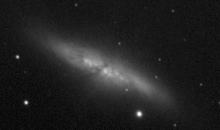SN 2014J

First image: Messier 82 on 10 December 2013. Second image: The same view on 22 January 2014. The position of the supernova is marked.
|
|
| Event type |
Supernova |
|---|---|
| Spectral class | Type Ia |
| Observation | |
| Date | 21 January 2014, 21 January 2014 |
| Instrument |
UCL Observatory |
| Location | |
| Constellation |
Ursa Major |
| Right ascension | 9h 55m 42.217s |
| Declination | 69° 40′ 26.56″ |
| Epoch | J2000 |
| Distance | 11,500,000 ly (3,500,000 pc) |
| Host | Messier 82 |
| Characteristics | |
| Progenitor | unknown |
| Notable features | Closest Type Ia for 40 years |
| Energetics | |
| See also | |
|
[]
|
|
Coordinates: ![]() 9h 55m 42.217s, +69° 40′ 26.56″
9h 55m 42.217s, +69° 40′ 26.56″
SN 2014J was a type-Ia supernova in Messier 82 (the 'Cigar Galaxy', M82) discovered in mid-January 2014. It was the closest type-Ia supernova discovered for 42 years, and none have been closer as of 2016[update]. The supernova was discovered by chance during an undergraduate teaching session at University of London Observatory. It peaked on 31 January 2014, reaching an apparent magnitude of 10.5. SN 2014J was the subject of an intense observing campaign by professional astronomers, and was bright enough to be seen by amateur astronomers.
The supernova was discovered by astronomer Steve Fossey, of University College London. Fossey was training four undergraduate students (Ben Cooke, Guy Pollack, Matthew Wilde and Thomas Wright) to use a small 0.35-metre (14 in) telescope at University of London Observatory, located in Mill Hill, north London.
The discovery was serendipitous, because Fossey was not searching for supernovae, had not planned to look at M82, and only wanted to take advantage of a short gap in the London cloud cover. He later said that "The weather was closing in, with increasing cloud, so instead of the planned practical astronomy class, I gave the students an introductory demonstration of how to use the CCD camera on one of the observatory’s automated 0.35–metre telescopes."
...
Wikipedia
